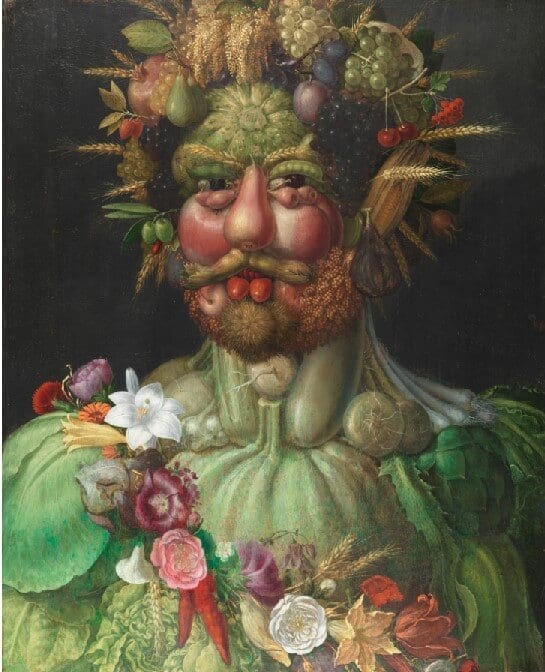Sue Reeves
London, United Kingdom
 |
| Vertumnus by Giuseppe Arcimboldo (1591) |
Arcimboldo (1527-1593) was an Italian painter most celebrated for his curious portraits of human heads composed of objects such as plants, fruit, and vegetables. The paintings have been described as “whimsical puzzle like portraits” and have retained their enchanting appeal over the years.1 Perhaps in the past children trying to replicate Arcimboldo’s work would have been discouraged from playing with their food, but in recent times research on food neophobia has shown that encouraging sensory play with fruit and vegetables can be an innovative way of encouraging young children to overcome their fears of trying new foods. Garnering inspiration from Arcimboldo’s work could potentially have nutritional benefits.
Creating faces with fruit and vegetables is a form of sensory play often used in nurseries and early years settings, and sensory play with food has been shown to be an effective method of reducing fear of novel foods.2 Food neophobia is common in children, who may refuse to try new foods, often restricting fruit and vegetable consumption, and thus limiting variety in their diet.3 Playing and designing pictures with food can help increase familiarity with new foods in a stress free way that does not exert any pressure on the child to eat them. Most forms of sensory play usually incorporate all the senses and encourages looking, smelling, feeling, tasting, even hearing sounds different foods make. A recent study in Finnish children aged eight to eleven years showed that sensory education may decrease neophobia and encourage children to taste new foods and increase dietary variety.4 Such initiatives have even been successful in pre-school aged children. In one study in the UK, children aged three to four years old were assigned to one of three groups; sensory fruit and vegetable play, sensory non-food play, and visual fruit and vegetable exposure. Sensory play that incorporated food was found to encourage the tasting and eating of fruit and vegetables more than both non-food play and visual exposure alone.5
Since many children fail to consume the recommended amounts of fruit and vegetables, imitating Arcimboldo’s work could help inspire and encourage them to become familiar with a variety of foods that can contribute to a healthy diet.
References
- Butler S (2017) Atlas of Eating. https://www.smithsonianmag.com/travel/food-art-cultural-travel-180961648/ Accessed 5 July 2018
- Dazeley P, Houston-Price C & Hill C (2012) Should healthy eating programmes incorporate interaction with foods in different sensory modalities? A review of the evidence. Brit J Nutr, 108, 769-777
- Cooke L, Wardle J & Gibson EL (2003) Relationship between parental report of food neophobia and everyday food consumption in 2-6 year old children. Appetite, 41, 206-206
- Mustonen S & Tuorila H (2010) Sensory education decreases food neophobia score and encourages trying unfamiliar foods in 8-12 year old children. Food Qual Pref, 21, 353-360
- Coulthard H & Sealy AM (2017) Play with your food! Sensory play is associated with tasting of fruits and vegetables in preschool children. Appetite, 113, 84-90
SUE REEVES, FAfN, RNutr, is a Fellow of the Association for Nutrition and the Head of Undergraduate Provision in the Life Sciences Department at the University of Roehampton, London.

Leave a Reply